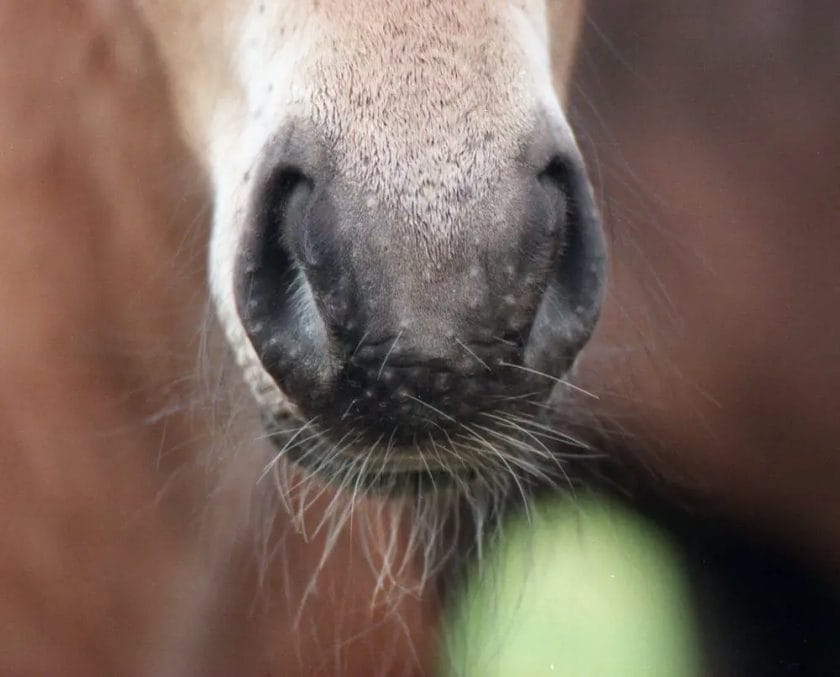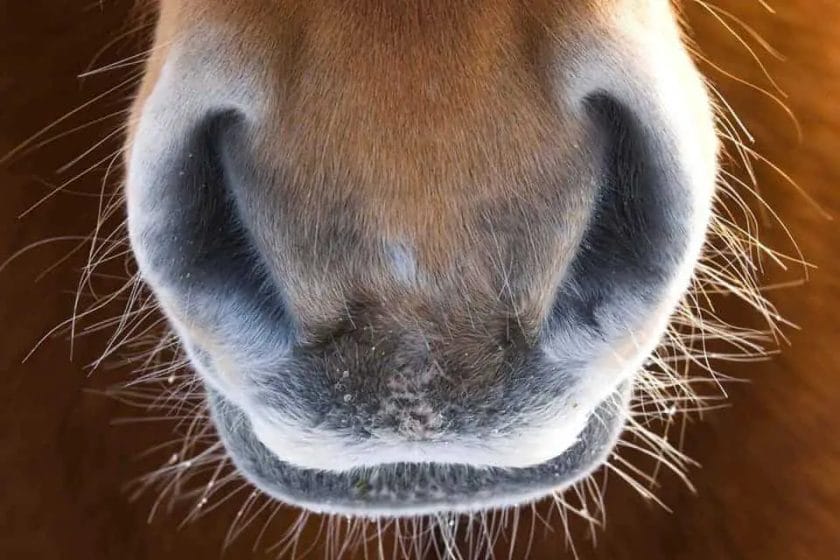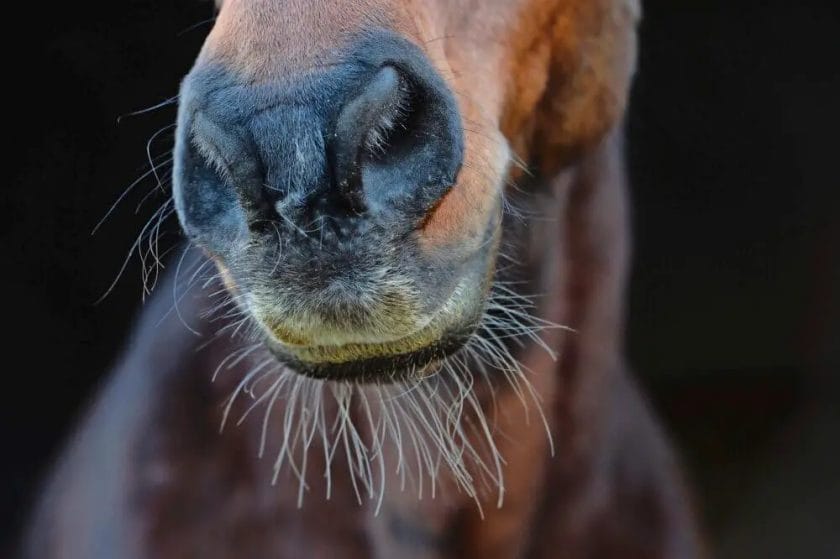Horses do have whiskers, and these serve an important purpose in their sensory perception. The whiskers, also known as vibrissae, are long, stiff hairs that are located mainly on the muzzle of the horse. They are highly sensitive and aid in detecting objects, gauging distances, and feeling the environment around them. Just like whiskers in other animals, horses’ whiskers play a crucial role in their daily activities, helping them navigate their surroundings and maintain their overall awareness.

The Anatomy of Horse Whiskers: Understanding their Structure and Growth
Horse whiskers, also known as vibrissae, are an important and intriguing feature of equine anatomy. They play a crucial role in sensory perception and communication for these magnificent creatures. In this section, we will delve into the intricate details of horse whiskers, exploring their structure and growth.
1. The Purpose of Horse Whiskers
Whiskers serve several essential functions for horses. Firstly, they act as sensory organs, providing vital information about the surrounding environment. Horse whiskers are highly sensitive and can detect even the slightest changes in air currents, enabling the animal to navigate and avoid potential obstacles.
Additionally, whiskers aid in social interactions between horses. They play a significant role in communication, as horses use their whiskers to touch and interact with each other, conveying various messages such as comfort, trust, and dominance.
2. Structure of Horse Whiskers
Horse whiskers are specialized tactile hairs that extend from various areas of the face, including the muzzle, chin, and above the eyes. They are much thicker and stiffer than regular hair, allowing them to withstand external stimuli without bending or breaking easily.
At the base of each whisker, there is a cluster of nerve endings surrounded by a capsule of blood vessels, which significantly enhances their sensitivity. This unique structure enables horses to perceive even the slightest touch or movement.
3. Growth and Shedding of Horse Whiskers
Unlike regular hair, horse whiskers have a relatively slow growth rate. On average, they grow approximately one centimeter per month. However, their growth is not continuous throughout the year, as horses experience seasonal shedding and regrowth.
Horses typically shed their whiskers during the spring, making room for new ones to grow. This shedding process allows the animal to adapt to seasonal changes and ensures the vitality and functionality of their whiskers.
4. Care and Maintenance of Horse Whiskers
As horse whiskers are crucial for sensory perception and communication, it is essential to handle them with care. Avoid trimming or cutting the whiskers, as this can disrupt the horse’s ability to gather information from its environment and communicate effectively.
Regular grooming practices should focus on maintaining the overall health and cleanliness of the horse’s face without disturbing the whiskers. Gentle brushing and cleaning around the whisker area will help prevent any debris or dirt from accumulating, ensuring that the whiskers can function optimally.
5. Appreciating the Wonders of Horse Whiskers
Understanding the anatomy and significance of horse whiskers allows us to appreciate the remarkable adaptations of these incredible animals. Their evolved structure and sensory capabilities contribute to their survival and social interactions, making them an integral part of horse physiology.
In summary, horse whiskers are not just ordinary hairs on a horse’s face. They serve as an essential sensory tool and aid in communication between horses. Their unique structure and slow growth rate contribute to their remarkable functionality. By respecting and caring for these whiskers, we can ensure the well-being and natural abilities of our equine companions.

Whisker Sensitivity in Horses: How it Helps with Orientation and Communication
Horses are remarkable creatures with a wide range of sensory adaptations that help them survive in their environment. One such adaptation is their whiskers, or vibrissae, which play a crucial role in their orientation and communication. In this section, we will explore the unique abilities of horses’ whiskers and how they contribute to their overall well-being.
1. What are Whiskers and How are They Different in Horses?
Whiskers are specialized hairs that are longer, stiffer, and more deeply embedded in the skin than regular hairs. They are highly sensitive tactile organs that are innervated with nerves, allowing horses to gather important information about their surroundings. Unlike other animals, horses have whiskers not only on their face but also on their chin and lower legs.
2. Orienting in the Dark: Whiskers as ‘Touch Sensors’
Horses are known for their exceptional night vision, but their whiskers also play a vital role in helping them navigate in low-light conditions. These whiskers function like touch sensors, allowing the horse to detect objects and obstacles in their path. As they move, the whiskers bend, transmitting information to the sensory nerves, which then send signals to the horse’s brain for interpretation.
This sensory input helps horses avoid colliding with objects and gauging the width of narrow passages. It enables them to move with confidence and safety, even in dimly lit environments. By utilizing their whiskers, horses can effectively size up their surroundings and make quick, informed decisions.
3. Whiskers and Social Communication
In addition to aiding in orientation, horses’ whiskers also serve as a means of communication within their social groups. When horses interact with one another, they often engage in a behavior known as “whisker touching.” This involves lightly brushing their whiskers against the whiskers of another horse.
Whisker touching is believed to be a form of social bonding and communication. It allows horses to exchange information, convey emotions, and establish trust and familiarity with one another. This behavior is particularly important during grooming sessions, as horses use their whiskers to explore one another’s bodies and detect any irregularities or parasites.
4. The Importance of Whisker Sensitivity in Domestic Horses
While wild horses have the advantage of living in their natural environment, domesticated horses can also benefit from their whiskers. Whisker sensitivity in domestic horses can help prevent accidents and injuries, especially when navigating unfamiliar or challenging terrain.
It is crucial for horse owners and caretakers to respect and preserve the integrity of a horse’s whiskers. Trimming or removing their whiskers can significantly disrupt their ability to gather essential sensory information. Moreover, it can cause unnecessary stress and discomfort to the horse.
5. Conclusion
In summary, whisker sensitivity plays an integral role in a horse’s orientation and communication. These specialized hairs function as touch sensors, providing vital information about the horse’s surroundings, even in low-light conditions. Whiskers also serve as a means of social bonding and communication within the horse community.
Understanding and appreciating the importance of whiskers in horses can help ensure their well-being and promote effective communication between horses and their human caretakers. By allowing horses to utilize their natural sensory adaptations, we can enhance their quality of life and establish a deeper bond with these magnificent animals.

Grooming and Caring for Horse Whiskers: Tips for Maintenance and Hygiene
Horse whiskers are not just a charming feature of these majestic creatures; they play an essential role in their sensory perception. Whiskers, also known as vibrissae, are highly sensitive and help horses navigate their surroundings. As a responsible horse owner, it is crucial to understand the importance of grooming and caring for your horse’s whiskers to ensure their well-being. In this section, we will discuss some tips for maintaining and promoting proper hygiene for horse whiskers.
The Role of Horse Whiskers
Horse whiskers serve multiple purposes. They act as sensory organs, providing valuable information about the horse’s environment. Whiskers can detect changes in air currents, allowing horses to sense approaching objects or predators. They also aid in the horse’s perception of distance, helping them avoid collisions or navigate narrow passages. Moreover, whiskers are involved in social interactions among horses, enabling gentle touch and communication.
Grooming Horse Whiskers
When it comes to grooming horse whiskers, it is essential to strike a balance between keeping them clean and maintaining their functionality. Here are some tips to help you with this process:
- Regular Inspection: Begin by inspecting your horse’s whiskers regularly. Look for any signs of damage, such as breakage or inflammation. If you notice any issues, consult with a veterinarian for appropriate treatment.
- Trimming: While some horse owners choose to trim their horse’s whiskers for aesthetic reasons, it is generally recommended to leave them untrimmed. Whiskers naturally shed and regrow, so interfering with this process can disrupt their sensory function. However, if you participate in specific competitions where trimming is required, ensure you follow the guidelines provided.
- Cleaning: Whiskers can accumulate dirt, debris, and food particles. Gently clean your horse’s whiskers using a damp cloth or soft brush. Avoid using harsh soaps or chemicals that can irritate the skin. Regular cleaning helps maintain hygiene and prevents any discomfort for your horse.
- Protection: It is important to protect your horse’s whiskers during activities that may pose a risk of damage. For instance, when turning out your horse in a pasture with dense brush or branches, consider using a protective mask or hood to safeguard the whiskers.
Promoting Whisker Health
In addition to grooming, there are several measures you can take to promote overall whisker health:
- Nutrition: Provide your horse with a balanced diet rich in essential nutrients, as this plays a vital role in maintaining healthy whiskers. Consult with a veterinarian or equine nutritionist for appropriate dietary recommendations.
- Regular Veterinary Care: Schedule regular check-ups with your horse’s veterinarian to ensure their overall health. Any underlying health issues can affect the condition of the whiskers and other sensory organs.
- Stress Reduction: Minimize stress in your horse’s environment, as stress can negatively impact their overall well-being, including the condition of their whiskers. Provide a calm and stable living environment and incorporate relaxation techniques into their routine, such as regular turnout, social interactions, or grooming sessions.
In summary, proper grooming and care for horse whiskers are crucial for their overall well-being. Understanding the role of whiskers, regular inspection, gentle cleaning, and protection from potential damage are essential steps in maintaining their health and functionality. Additionally, providing a nutritious diet and ensuring regular veterinary care contribute to promoting healthy whiskers and a happy, thriving equine companion.
Whisker Trimming in Horses: Pros and Cons of this Controversial Practice
Whisker trimming in horses is a controversial practice that has been a topic of debate among horse owners, trainers, and veterinarians. Whiskers, also known as vibrissae, are long, tactile hairs found on the muzzle, eyes, and chin of horses. They serve an important sensory function and play a vital role in a horse’s perception of its surroundings. In this section, we will explore the pros and cons of whisker trimming in horses.
Pros of Whisker Trimming
Proponents of whisker trimming argue that it can have certain benefits for horses in specific situations. Here are some of the potential advantages:
- Appearance: Some horse owners prefer the neat and tidy look of a trimmed muzzle. Whisker trimming can give a horse a cleaner appearance, especially in show or competition settings.
- Reduced Sensory Overload: Horses with exceptionally long whiskers may experience sensory overload in certain situations, such as when eating from a hay net. Trimming their whiskers may help reduce this sensory stimulation.
- Ease of Tack Application: Trimming the whiskers around the mouth can make it easier to fit bridles, bits, and other tack on the horse. This can help ensure a proper and comfortable fit.
- Facial Medication Application: Whisker trimming can facilitate the application of topical medications or ointments to the horse’s face, if necessary.
Cons of Whisker Trimming
On the other side of the debate, opponents of whisker trimming highlight the potential negative consequences and argue against this practice. Here are some of the cons associated with whisker trimming:
- Sensory Impairment: Whiskers provide horses with important sensory information that helps them navigate their environment. By trimming their whiskers, horses may experience a reduction in their ability to sense objects, potential dangers, and changes in their surroundings.
- Increased Risk of Injury: Without their whiskers, horses may be more prone to accidental injuries. Whiskers act as a protective mechanism by providing tactile feedback and helping horses avoid collisions or getting caught in narrow spaces.
- Disrupted Social Interactions: Whiskers play a role in horse-to-horse communication, especially during grooming and mutual grooming sessions. Trimming the whiskers may affect these interactions, potentially leading to social disruptions within a herd.
- Potential Discomfort: Some horses may find the process of whisker trimming uncomfortable or stressful. It can cause anxiety or distress, potentially impacting their overall well-being.
The Need for Responsible Decision-making
When it comes to whisker trimming in horses, it is crucial for horse owners and caretakers to make informed and responsible decisions. If considering whisker trimming, it is recommended to consult with a qualified veterinarian or equine professional who can assess the individual horse’s needs and provide guidance.
Ultimately, the decision to trim or not to trim whiskers should be based on the specific circumstances and requirements of the horse. Regular monitoring of the horse’s well-being and behavior should also be done to ensure that any potential negative effects are minimized.
In summary, whisker trimming in horses is a controversial practice with both pros and cons. While it may have certain aesthetic and functional benefits, it is important to consider the potential impact on a horse’s sensory perception, social interactions, and overall welfare. Responsible decision-making and consulting with professionals can help strike a balance between the desired outcomes and the well-being of the horse.
FAQs
Do horses have whiskers?
Yes, horses have whiskers. They are long, coarse hairs that are sensitive to touch. Whiskers can be found on the muzzle, chin, and around the eyes of a horse. They help the horse detect objects and navigate their surroundings.
Conclusion:
In conclusion, horses do have whiskers. These sensory hairs are located on various parts of their face, such as the muzzle, chin, and eyebrows. Whiskers serve an important purpose for horses, helping them to navigate their surroundings and detect objects in their path. They are highly sensitive and can provide valuable information about the environment, allowing horses to avoid potential dangers. Additionally, whiskers play a vital role in social interactions among horses, as they use them to communicate and establish boundaries. Therefore, whiskers are not just a characteristic feature of horses, but a crucial tool for their survival and social dynamics.
